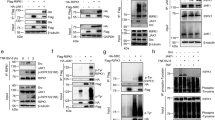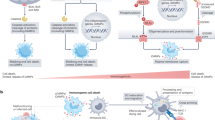Abstract
Death domain–containing receptors of the tumor necrosis factor (TNF)/nerve growth factor (NGF) family can induce apoptosis upon activation in many cellular systems. We show here that a conserved phosphotyrosine-containing motif within the death domain of these receptors can mediate inhibitory functions. The Src homology domain 2 (SH2)-containing tyrosine phosphatase-1 (SHP-1), SHP-2 and SH2-containing inositol phosphatase (SHIP) bound to this motif in a caspase-independent but cell-dependent manner. We also found that stimulation of death receptors disrupted anti-apoptosis pathways initiated (at least under certain conditions) by survival factors in neutrophils. In these cells, activation of the tyrosine kinase Lyn, an important anti-apoptotic event, was prevented as a consequence of death-receptor stimulation, most likely through association of the receptor with activated SHP-1. Thus, we provide molecular and functional evidence for negative signaling by death receptors.
This is a preview of subscription content, access via your institution
Access options
Subscribe to this journal
Receive 12 print issues and online access
$209.00 per year
only $17.42 per issue
Buy this article
- Purchase on Springer Link
- Instant access to full article PDF
Prices may be subject to local taxes which are calculated during checkout






Similar content being viewed by others
References
Peter, M.E. et al. Resistance of cultured peripheral T cells towards activation-induced cell death involves a lack of recruitment of FLICE (MACH/caspase 8) to the CD95 death-inducing signaling complex. Eur. J. Immunol. 27, 1207–1212 (1997).
Landowski, T.H., Gleason-Guzman, M.C. & Dalton, W.S. Selection for drug resistance to Fas-mediated apoptosis. Blood 89, 1854–1861 (1997).
Enari, M., Talanian, R.V., Wong, W.W. & Nagata, S. Sequential activation of ICE-like and CPP32-like proteases during Fas-mediated apoptosis. Nature 380, 723–726 (1996).
Thornberry, N.A. et al. A novel heterodimeric cysteine protease is required for interleukin-1β processing in monocytes. Nature 356, 768–774 (1992).
Cerretti, D.P. et al. Molecular cloning of the interleukin-1β converting enzyme. Science 256, 97–100 (1992).
Chinnaiyan, A.M., O'Rourke, K., Tewari, M. & Dixit, V.M. FADD, a novel death domain–containing protein, interacts with the death domain of Fas and initiates apoptosis. Cell 81, 505–512 (1995).
Newton, K., Harris, A.W., Bath, M.L., Smith, K.G.C. & Strasser, A. A dominant interfering mutant of FADD/MORT1 enhances deletion of autoreactive thymocytes and inhibits proliferation of mature T lymphocytes. EMBO J. 17, 706–718 (1998).
Walsh, C.M. et al. A role for FADD in T cell activation and development. Immunity 8, 439–449 (1998).
Allison, J., Georgiou, H.M., Strasser, A. & Vaux, D.L. Transgenic expression of CD95 ligand on islet beta cells induces a granulocytic infiltration but does not confer immune privilege upon islet allografts. Proc. Natl. Acad. Sci. USA 94, 3943–3947 (1997).
Liles, W.C., Kiener, P.A., Ledbetter, J.A., Aruffo, A. & Klebanoff, S.J. Differential expression of Fas (CD95) and Fas ligand on normal human phagocytes: implications for the regulation of apoptosis in neutrophils. J. Exp. Med. 184, 429–440 (1996).
Savill, J.S. et al. Macrophage phagocytosis of aging neutrophils in inflammation. Programmed cell death in the neutrophil leads to its recognition by macrophages. J. Clin. Invest. 83, 865–875 (1989).
Dibbert, B. et al. Cytokine-mediated Bax deficiency and consequent delayed neutrophil apoptosis: a general mechanism to accumulate effector cells in inflammation. Proc. Natl. Acad. Sci. USA 96, 13330–13335 (1999).
Green, D.R. Apoptotic pathways: the roads to ruin. Cell 94, 695–698 (1998).
Gradl, G. et al. The CD95 (Fas/APO-1) receptor is phosphorylated in vitro and in vivo and constitutively associates with several cellular proteins. Apoptosis 1, 131–140 (1996).
Su, X., Zhou, T., Yang, P.A., Wang, Z. & Moritz, J.D. Defective expression of hematopoietic cell protein tyrosine phosphatase (HCP) in lymphoid cells blocks Fas-mediated apoptosis. Immunity 2, 353–362 (1995).
Hsu, H., Xiong, J. & Goeddel, D.V. The TNF receptor 1–associated protein TRADD signals cell death and NF-κB activation. Cell 81, 495–504 (1995).
Wei, S. et al. Critical role of Lyn kinase in inhibition of neutrophil apoptosis by granulocyte-macrophage colony-stimulating factor. J. Immunol. 157, 5155–5162 (1996).
Yousefi, S., Hoessli, D.C., Blaser, K., Mills, G.B. & Simon, H.-U. Requirement of Lyn and Syk tyrosine kinases for the prevention of apoptosis by cytokines in human eosinophils. J. Exp. Med. 183, 1407–1414 (1996).
Simon, H.-U. et al. Anti-apoptotic signals of granulocyte-macrophage colony-stimulating factor are transduced via Jak2 tyrosine kinase in eosinophils. Eur. J. Immunol. 27, 3536–3539 (1997).
Pazdrak, K., Olszewska-Pazdrak, B., Stafford, S., Garofalo, R.P. & Alam, R. Lyn, Jak2, and Raf-1 kinases are critical for the antiapoptotic effect of interleukin-5, whereas only Raf-1 kinase is essential for eosinophil activation and degranulation. J. Exp. Med. 188, 421–429 (1998).
Shultz, L.D. et al. Mutations at the murine motheaten locus are within the hematopoietic cell protein-tyrosine phosphatase (Hcph) gene. Cell 73, 1445–1454 (1993).
Cambier, J.S. Inhibitory receptors abound? Proc. Natl. Acad. Sci. USA 94, 5993–5995 (1997).
Marengere, L.E.M. et al. SH2 domain specificity and activity modified by a single residue. Nature 369, 502–505 (1994).
Thangaraju, M. et al. Regulation of acidification and apoptosis by SHP-1 and Bcl-2. J. Biol. Chem. 274, 29549–29557 (1999).
Guo, D.-Q. et al. Tumor necrosis factor employs a protein-tyrosine phosphatase to inhibit activation of KDR and vascular endothelial cell growth factor–induced endothelial cell proliferation. J. Biol. Chem. 275, 11216–11221 (2000).
Pongracz, J. et al. Spontaneous neutrophil apoptosis involves caspase 3–mediated activation of protein kinase Cδ. J. Biol. Chem. 274, 37329–37334 (1999).
Khwaja, A. & Tatton, L. Caspase-mediated proteolysis and activation of protein kinase Cδ plays a central role in neutrophil apoptosis. Blood 94, 291–301 (1999).
Holler, N. et al. Fas triggers an alternative, caspase-8–independent cell death pathway using the kinase RIP as effector molecule. Nature Immunol. 1, 489–495 (2000).
Unkeless, J.C. & Jin, J. Inhibitory receptors, ITIM sequences and phosphatases. Curr. Opin. Immunol. 9, 338–343 (1997).
Guthmann, M.D., Tal, M. & Pecht, I. A secretion inhibitory signal transduction molecule on mast cells is another C-type lectin. Proc. Natl. Acad. Sci. USA 92, 9397–9401 (1995).
Fleming, T.J. et al. Negative regulation of FcɛRI-mediated degranulation by CD81. J. Exp. Med. 186, 1307–1314 (1997).
Colonna, M. et al. A common inhibitory receptor for major histocompatibility complex class I molecules on human lymphoid and myelomonocytic cells. J. Exp. Med. 186, 1809–1818 (1997).
Cremesti, A. et al. Ceramide enables Fas to cap and kill. J. Biol. Chem. 276, 23954–23961 (2001).
Marino, M.W. et al. Characterization of tumor necrosis factor–deficient mice. Proc. Natl. Acad. Sci. USA 94, 8093–8098 (1997).
Rebel, V.I. et al. Essential role for the p55 tumor necrosis factor receptor in regulating hematopoiesis at a stem cell level. J. Exp. Med. 190, 1493–1503 (1999).
Smith, K.G., Strasser, A. & Vaux, D.L. CrmA expression in T lymphocytes of transgenic mice inhibits CD95 (Fas/APO-1)–transduced apoptosis, but does not cause lymphadenopathy or autoimmune disease. EMBO J. 15, 5167–5176 (1996).
Song, K. et al. Tumor necrosis factor–related apoptosis-inducing ligand (TRAIL) is an inhibitor of autoimmune inflammation and cell cycle progression. J. Exp. Med. 191, 1095–1103 (2000).
Pan, G. et al. An antagonist decoy receptor and a death domain–containing receptor for TRAIL. Science 277, 815–818 (1997).
Sheridan, J.P. et al. Control of TRAIL-induced apoptosis by a family of signaling and decoy receptors. Science 277, 818–821 (1997).
Pazdrak, K., Adachi, T. & Alam, R. Src homology 2 protein tyrosine phosphatase (SHPTP2)/Src homology 2 phosphatase 2 (SHP2) tyrosine phosphatase is a positive regulator of the interleukin-5 receptor signal transduction pathways leading to the prolongation of eosinophil survival. J. Exp. Med. 186, 561–568 (1997).
Yousefi, S., Green, D. R., Blaser, K. & Simon, H.-U. Protein-tyrosine phosphorylation regulates apoptosis in human eosinophils and neutrophils. Proc. Natl. Acad. Sci. USA 91, 10868–10872 (1994).
Kamps, M. P. & Sefton, B.M. Acid and base hydrolysis of phosphoproteins bound to Immobilon facilitates the analysis of phosphoamino acids in gel-fractionated proteins. Anal. Biochem. 176, 22–27 (1989).
Chartier, C., Degryse, E., Gantzer, M., Dieterle, A., Pavirani, A. & Mehtali, M. Efficient generation of recombinant adenovirus vectors by homologous recombination in Escherichia coli. J. Virol. 70, 4805–4810 (1996).
Acknowledgements
We thank L. Rohrschneider for the SHIP-specific antibody; M. Peter for Jurkat (J16) cells; A. Ziemiecki and R. Friis for help with the phosphoamino acid analysis and adenovirus infection experiments; and I. Schmid for technical assistance. This work was supported by grants from the Swiss National Science Foundation and the Helmut Horten Foundation (Madonna del Piano).
Author information
Authors and Affiliations
Corresponding author
Ethics declarations
Competing interests
The authors declare no competing financial interests.
Rights and permissions
About this article
Cite this article
Daigle, I., Yousefi, S., Colonna, M. et al. Death receptors bind SHP-1 and block cytokine-induced anti-apoptotic signaling in neutrophils. Nat Med 8, 61–67 (2002). https://doi.org/10.1038/nm0102-61
Received:
Accepted:
Issue Date:
DOI: https://doi.org/10.1038/nm0102-61
This article is cited by
-
SHP-1/STAT3 Interaction Is Related to Luteolin-Induced Myocardial Ischemia Protection
Inflammation (2022)
-
Modulation of CD95-mediated signaling by post-translational modifications: towards understanding CD95 signaling networks
Apoptosis (2019)
-
Counterbalance: modulation of VEGF/VEGFR activities by TNFSF15
Signal Transduction and Targeted Therapy (2018)
-
The Btk-dependent PIP5K1γ lipid kinase activation by Fas counteracts FasL-induced cell death
Apoptosis (2017)
-
CD95 promotes metastatic spread via Sck in pancreatic ductal adenocarcinoma
Cell Death & Differentiation (2015)



